Critical Evaluation of Leadership Styles in Risk Management
VerifiedAdded on 2023/06/10
|8
|2222
|61
Report
AI Summary
This report critically evaluates leadership styles, specifically focusing on situational and transactional leadership models, within the context of risk management in the nuclear energy sector. The analysis begins by defining leadership and leadership styles, highlighting the importance of effective leadership for corporate governance and risk management. The report emphasizes the relevance of situational and transactional leadership, particularly in high-pressure environments like the nuclear energy sector. Situational leadership is presented as a task-oriented approach that adapts to changing circumstances, while transactional leadership focuses on exchanges between leaders and team members to achieve organizational goals. The report contrasts transactional leadership with transformational leadership, explaining why the former is more applicable in the given scenario. The report concludes that the most effective approach to managing risks in the nuclear energy sector involves a combination of situational and transactional leadership styles, emphasizing clear communication, defined roles, and a focus on performance standards. The report also uses the Emirates Nuclear Energy Corporation (ENEC) as a case study to illustrate the practical application of these leadership styles.
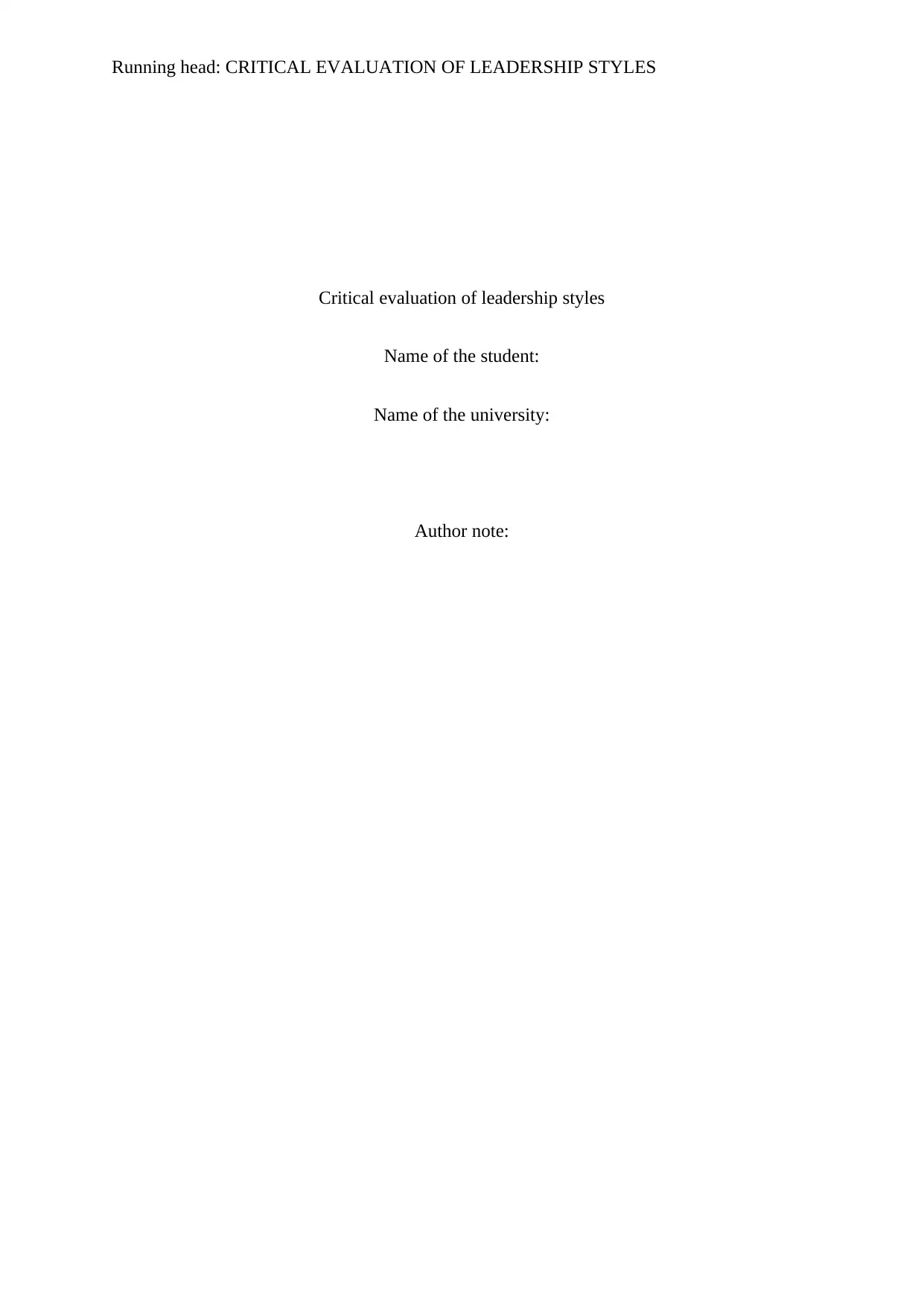
Running head: CRITICAL EVALUATION OF LEADERSHIP STYLES
Critical evaluation of leadership styles
Name of the student:
Name of the university:
Author note:
Critical evaluation of leadership styles
Name of the student:
Name of the university:
Author note:
Paraphrase This Document
Need a fresh take? Get an instant paraphrase of this document with our AI Paraphraser
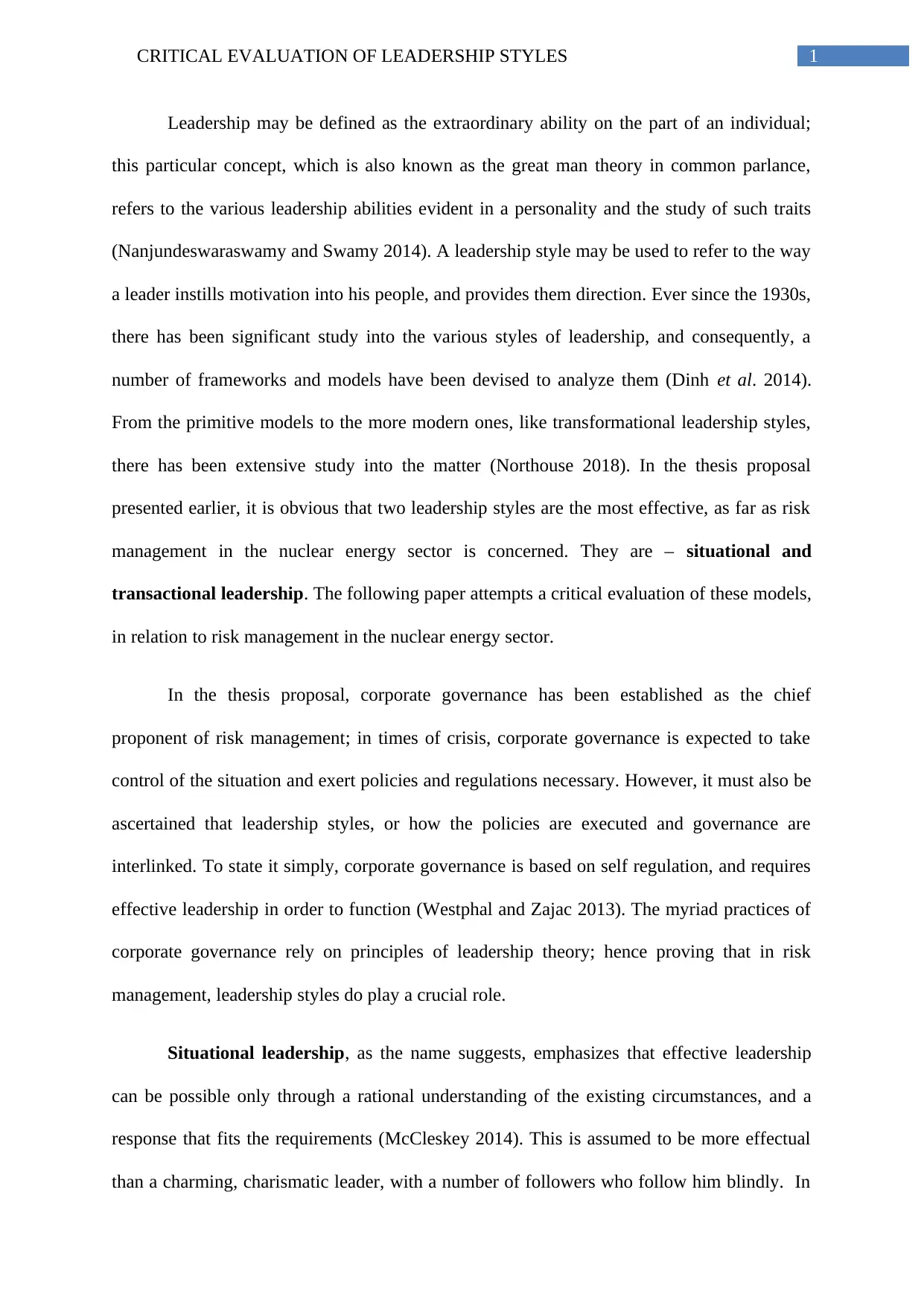
1CRITICAL EVALUATION OF LEADERSHIP STYLES
Leadership may be defined as the extraordinary ability on the part of an individual;
this particular concept, which is also known as the great man theory in common parlance,
refers to the various leadership abilities evident in a personality and the study of such traits
(Nanjundeswaraswamy and Swamy 2014). A leadership style may be used to refer to the way
a leader instills motivation into his people, and provides them direction. Ever since the 1930s,
there has been significant study into the various styles of leadership, and consequently, a
number of frameworks and models have been devised to analyze them (Dinh et al. 2014).
From the primitive models to the more modern ones, like transformational leadership styles,
there has been extensive study into the matter (Northouse 2018). In the thesis proposal
presented earlier, it is obvious that two leadership styles are the most effective, as far as risk
management in the nuclear energy sector is concerned. They are – situational and
transactional leadership. The following paper attempts a critical evaluation of these models,
in relation to risk management in the nuclear energy sector.
In the thesis proposal, corporate governance has been established as the chief
proponent of risk management; in times of crisis, corporate governance is expected to take
control of the situation and exert policies and regulations necessary. However, it must also be
ascertained that leadership styles, or how the policies are executed and governance are
interlinked. To state it simply, corporate governance is based on self regulation, and requires
effective leadership in order to function (Westphal and Zajac 2013). The myriad practices of
corporate governance rely on principles of leadership theory; hence proving that in risk
management, leadership styles do play a crucial role.
Situational leadership, as the name suggests, emphasizes that effective leadership
can be possible only through a rational understanding of the existing circumstances, and a
response that fits the requirements (McCleskey 2014). This is assumed to be more effectual
than a charming, charismatic leader, with a number of followers who follow him blindly. In
Leadership may be defined as the extraordinary ability on the part of an individual;
this particular concept, which is also known as the great man theory in common parlance,
refers to the various leadership abilities evident in a personality and the study of such traits
(Nanjundeswaraswamy and Swamy 2014). A leadership style may be used to refer to the way
a leader instills motivation into his people, and provides them direction. Ever since the 1930s,
there has been significant study into the various styles of leadership, and consequently, a
number of frameworks and models have been devised to analyze them (Dinh et al. 2014).
From the primitive models to the more modern ones, like transformational leadership styles,
there has been extensive study into the matter (Northouse 2018). In the thesis proposal
presented earlier, it is obvious that two leadership styles are the most effective, as far as risk
management in the nuclear energy sector is concerned. They are – situational and
transactional leadership. The following paper attempts a critical evaluation of these models,
in relation to risk management in the nuclear energy sector.
In the thesis proposal, corporate governance has been established as the chief
proponent of risk management; in times of crisis, corporate governance is expected to take
control of the situation and exert policies and regulations necessary. However, it must also be
ascertained that leadership styles, or how the policies are executed and governance are
interlinked. To state it simply, corporate governance is based on self regulation, and requires
effective leadership in order to function (Westphal and Zajac 2013). The myriad practices of
corporate governance rely on principles of leadership theory; hence proving that in risk
management, leadership styles do play a crucial role.
Situational leadership, as the name suggests, emphasizes that effective leadership
can be possible only through a rational understanding of the existing circumstances, and a
response that fits the requirements (McCleskey 2014). This is assumed to be more effectual
than a charming, charismatic leader, with a number of followers who follow him blindly. In
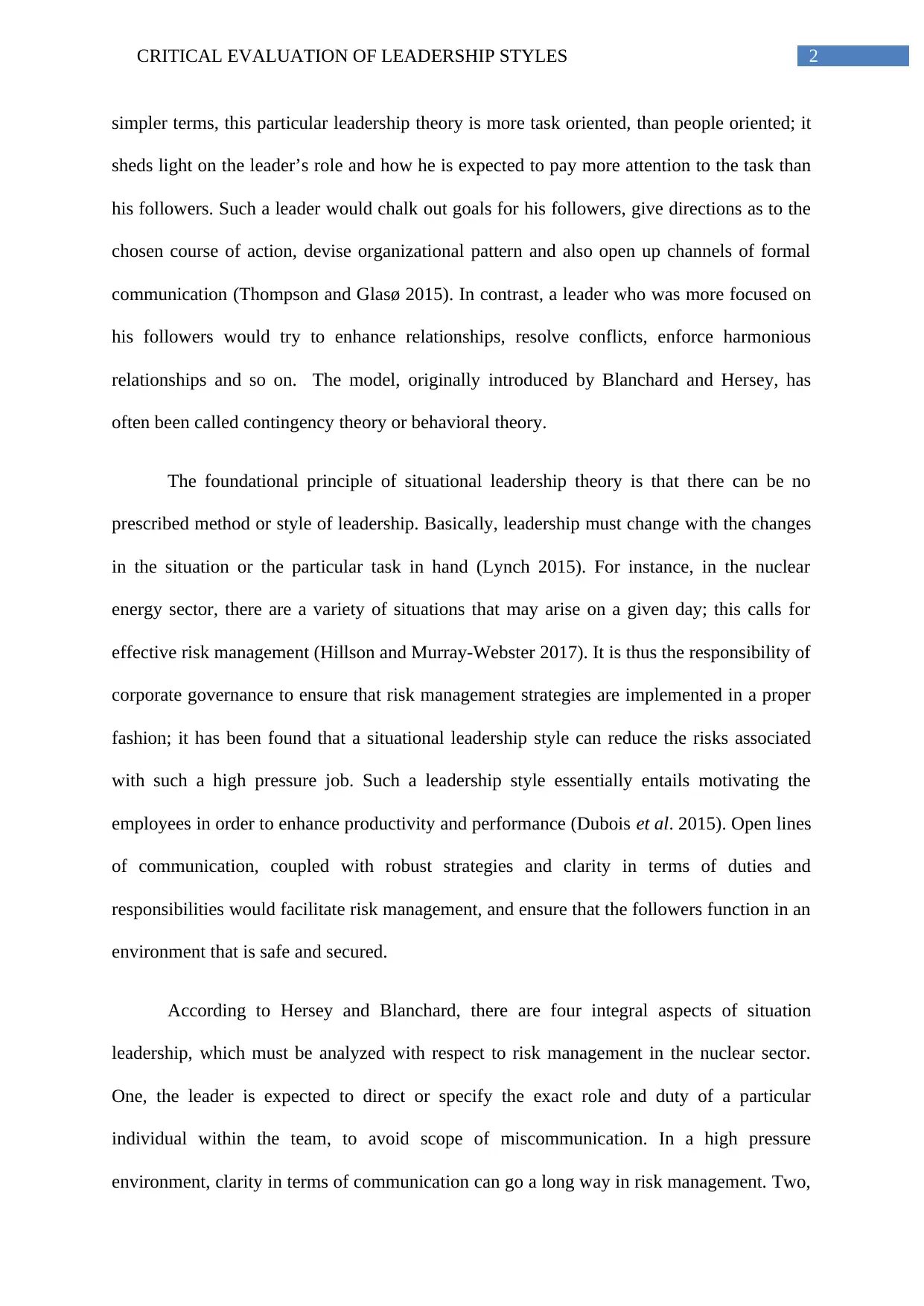
2CRITICAL EVALUATION OF LEADERSHIP STYLES
simpler terms, this particular leadership theory is more task oriented, than people oriented; it
sheds light on the leader’s role and how he is expected to pay more attention to the task than
his followers. Such a leader would chalk out goals for his followers, give directions as to the
chosen course of action, devise organizational pattern and also open up channels of formal
communication (Thompson and Glasø 2015). In contrast, a leader who was more focused on
his followers would try to enhance relationships, resolve conflicts, enforce harmonious
relationships and so on. The model, originally introduced by Blanchard and Hersey, has
often been called contingency theory or behavioral theory.
The foundational principle of situational leadership theory is that there can be no
prescribed method or style of leadership. Basically, leadership must change with the changes
in the situation or the particular task in hand (Lynch 2015). For instance, in the nuclear
energy sector, there are a variety of situations that may arise on a given day; this calls for
effective risk management (Hillson and Murray-Webster 2017). It is thus the responsibility of
corporate governance to ensure that risk management strategies are implemented in a proper
fashion; it has been found that a situational leadership style can reduce the risks associated
with such a high pressure job. Such a leadership style essentially entails motivating the
employees in order to enhance productivity and performance (Dubois et al. 2015). Open lines
of communication, coupled with robust strategies and clarity in terms of duties and
responsibilities would facilitate risk management, and ensure that the followers function in an
environment that is safe and secured.
According to Hersey and Blanchard, there are four integral aspects of situation
leadership, which must be analyzed with respect to risk management in the nuclear sector.
One, the leader is expected to direct or specify the exact role and duty of a particular
individual within the team, to avoid scope of miscommunication. In a high pressure
environment, clarity in terms of communication can go a long way in risk management. Two,
simpler terms, this particular leadership theory is more task oriented, than people oriented; it
sheds light on the leader’s role and how he is expected to pay more attention to the task than
his followers. Such a leader would chalk out goals for his followers, give directions as to the
chosen course of action, devise organizational pattern and also open up channels of formal
communication (Thompson and Glasø 2015). In contrast, a leader who was more focused on
his followers would try to enhance relationships, resolve conflicts, enforce harmonious
relationships and so on. The model, originally introduced by Blanchard and Hersey, has
often been called contingency theory or behavioral theory.
The foundational principle of situational leadership theory is that there can be no
prescribed method or style of leadership. Basically, leadership must change with the changes
in the situation or the particular task in hand (Lynch 2015). For instance, in the nuclear
energy sector, there are a variety of situations that may arise on a given day; this calls for
effective risk management (Hillson and Murray-Webster 2017). It is thus the responsibility of
corporate governance to ensure that risk management strategies are implemented in a proper
fashion; it has been found that a situational leadership style can reduce the risks associated
with such a high pressure job. Such a leadership style essentially entails motivating the
employees in order to enhance productivity and performance (Dubois et al. 2015). Open lines
of communication, coupled with robust strategies and clarity in terms of duties and
responsibilities would facilitate risk management, and ensure that the followers function in an
environment that is safe and secured.
According to Hersey and Blanchard, there are four integral aspects of situation
leadership, which must be analyzed with respect to risk management in the nuclear sector.
One, the leader is expected to direct or specify the exact role and duty of a particular
individual within the team, to avoid scope of miscommunication. In a high pressure
environment, clarity in terms of communication can go a long way in risk management. Two,
⊘ This is a preview!⊘
Do you want full access?
Subscribe today to unlock all pages.

Trusted by 1+ million students worldwide
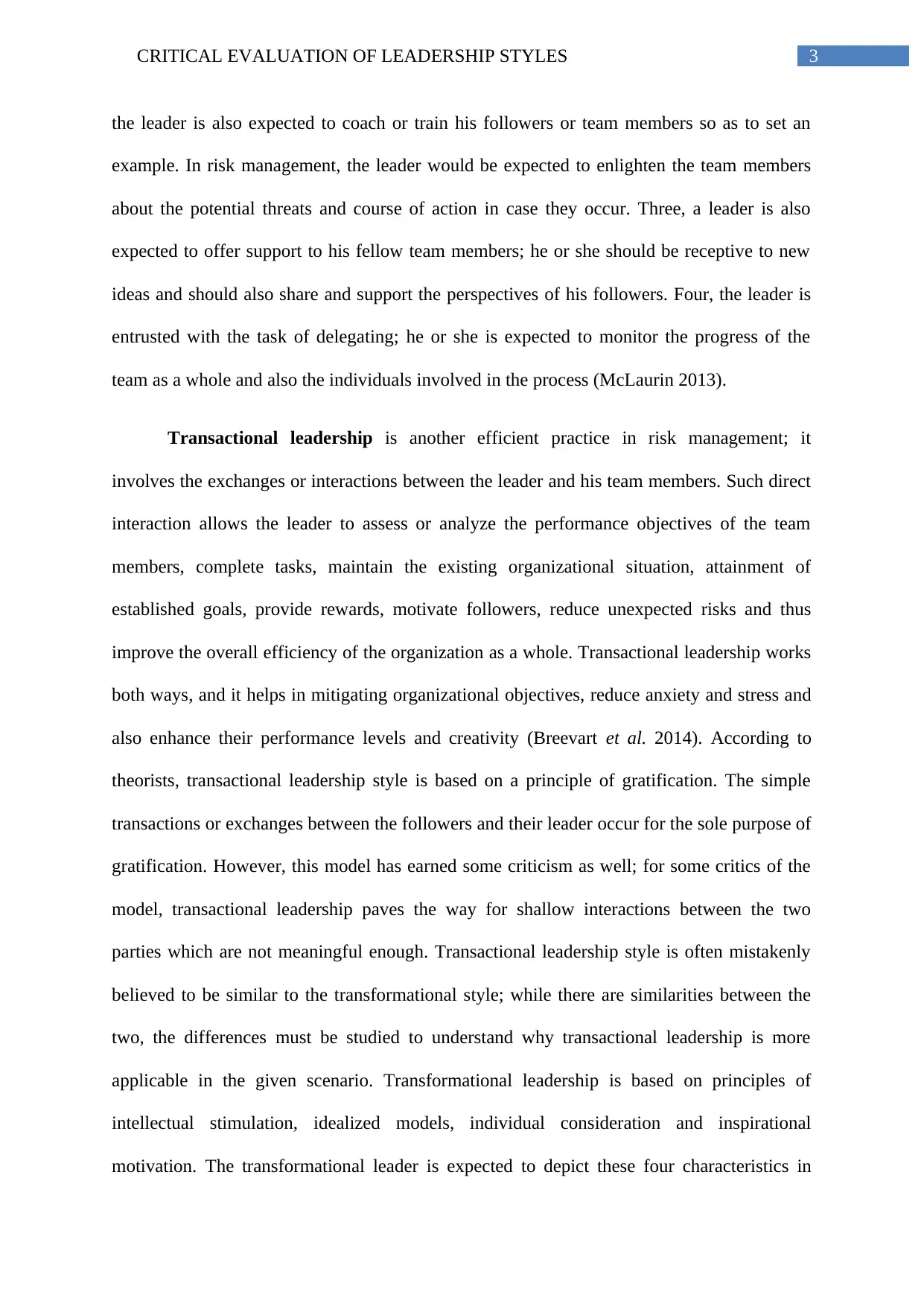
3CRITICAL EVALUATION OF LEADERSHIP STYLES
the leader is also expected to coach or train his followers or team members so as to set an
example. In risk management, the leader would be expected to enlighten the team members
about the potential threats and course of action in case they occur. Three, a leader is also
expected to offer support to his fellow team members; he or she should be receptive to new
ideas and should also share and support the perspectives of his followers. Four, the leader is
entrusted with the task of delegating; he or she is expected to monitor the progress of the
team as a whole and also the individuals involved in the process (McLaurin 2013).
Transactional leadership is another efficient practice in risk management; it
involves the exchanges or interactions between the leader and his team members. Such direct
interaction allows the leader to assess or analyze the performance objectives of the team
members, complete tasks, maintain the existing organizational situation, attainment of
established goals, provide rewards, motivate followers, reduce unexpected risks and thus
improve the overall efficiency of the organization as a whole. Transactional leadership works
both ways, and it helps in mitigating organizational objectives, reduce anxiety and stress and
also enhance their performance levels and creativity (Breevart et al. 2014). According to
theorists, transactional leadership style is based on a principle of gratification. The simple
transactions or exchanges between the followers and their leader occur for the sole purpose of
gratification. However, this model has earned some criticism as well; for some critics of the
model, transactional leadership paves the way for shallow interactions between the two
parties which are not meaningful enough. Transactional leadership style is often mistakenly
believed to be similar to the transformational style; while there are similarities between the
two, the differences must be studied to understand why transactional leadership is more
applicable in the given scenario. Transformational leadership is based on principles of
intellectual stimulation, idealized models, individual consideration and inspirational
motivation. The transformational leader is expected to depict these four characteristics in
the leader is also expected to coach or train his followers or team members so as to set an
example. In risk management, the leader would be expected to enlighten the team members
about the potential threats and course of action in case they occur. Three, a leader is also
expected to offer support to his fellow team members; he or she should be receptive to new
ideas and should also share and support the perspectives of his followers. Four, the leader is
entrusted with the task of delegating; he or she is expected to monitor the progress of the
team as a whole and also the individuals involved in the process (McLaurin 2013).
Transactional leadership is another efficient practice in risk management; it
involves the exchanges or interactions between the leader and his team members. Such direct
interaction allows the leader to assess or analyze the performance objectives of the team
members, complete tasks, maintain the existing organizational situation, attainment of
established goals, provide rewards, motivate followers, reduce unexpected risks and thus
improve the overall efficiency of the organization as a whole. Transactional leadership works
both ways, and it helps in mitigating organizational objectives, reduce anxiety and stress and
also enhance their performance levels and creativity (Breevart et al. 2014). According to
theorists, transactional leadership style is based on a principle of gratification. The simple
transactions or exchanges between the followers and their leader occur for the sole purpose of
gratification. However, this model has earned some criticism as well; for some critics of the
model, transactional leadership paves the way for shallow interactions between the two
parties which are not meaningful enough. Transactional leadership style is often mistakenly
believed to be similar to the transformational style; while there are similarities between the
two, the differences must be studied to understand why transactional leadership is more
applicable in the given scenario. Transformational leadership is based on principles of
intellectual stimulation, idealized models, individual consideration and inspirational
motivation. The transformational leader is expected to depict these four characteristics in
Paraphrase This Document
Need a fresh take? Get an instant paraphrase of this document with our AI Paraphraser
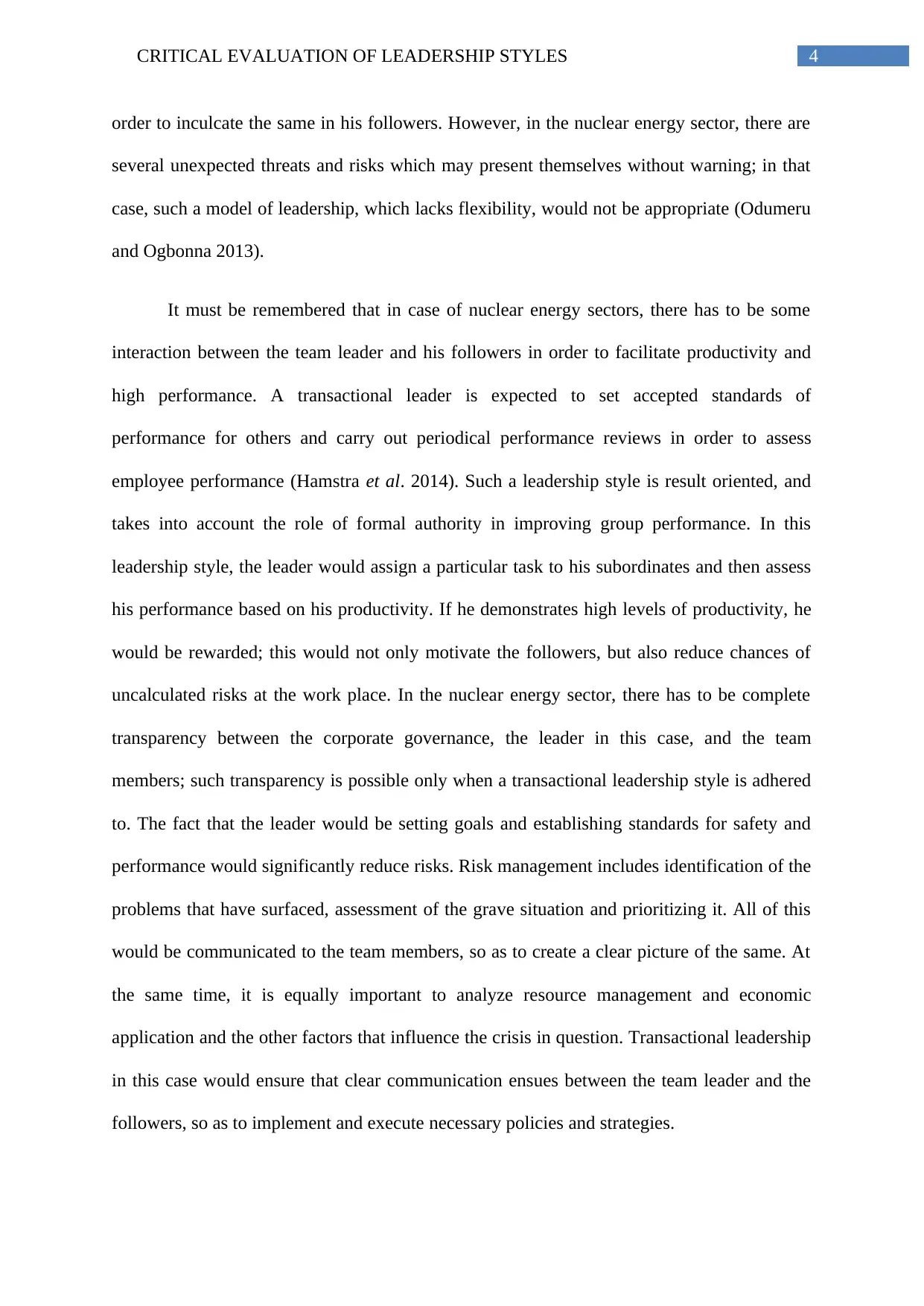
4CRITICAL EVALUATION OF LEADERSHIP STYLES
order to inculcate the same in his followers. However, in the nuclear energy sector, there are
several unexpected threats and risks which may present themselves without warning; in that
case, such a model of leadership, which lacks flexibility, would not be appropriate (Odumeru
and Ogbonna 2013).
It must be remembered that in case of nuclear energy sectors, there has to be some
interaction between the team leader and his followers in order to facilitate productivity and
high performance. A transactional leader is expected to set accepted standards of
performance for others and carry out periodical performance reviews in order to assess
employee performance (Hamstra et al. 2014). Such a leadership style is result oriented, and
takes into account the role of formal authority in improving group performance. In this
leadership style, the leader would assign a particular task to his subordinates and then assess
his performance based on his productivity. If he demonstrates high levels of productivity, he
would be rewarded; this would not only motivate the followers, but also reduce chances of
uncalculated risks at the work place. In the nuclear energy sector, there has to be complete
transparency between the corporate governance, the leader in this case, and the team
members; such transparency is possible only when a transactional leadership style is adhered
to. The fact that the leader would be setting goals and establishing standards for safety and
performance would significantly reduce risks. Risk management includes identification of the
problems that have surfaced, assessment of the grave situation and prioritizing it. All of this
would be communicated to the team members, so as to create a clear picture of the same. At
the same time, it is equally important to analyze resource management and economic
application and the other factors that influence the crisis in question. Transactional leadership
in this case would ensure that clear communication ensues between the team leader and the
followers, so as to implement and execute necessary policies and strategies.
order to inculcate the same in his followers. However, in the nuclear energy sector, there are
several unexpected threats and risks which may present themselves without warning; in that
case, such a model of leadership, which lacks flexibility, would not be appropriate (Odumeru
and Ogbonna 2013).
It must be remembered that in case of nuclear energy sectors, there has to be some
interaction between the team leader and his followers in order to facilitate productivity and
high performance. A transactional leader is expected to set accepted standards of
performance for others and carry out periodical performance reviews in order to assess
employee performance (Hamstra et al. 2014). Such a leadership style is result oriented, and
takes into account the role of formal authority in improving group performance. In this
leadership style, the leader would assign a particular task to his subordinates and then assess
his performance based on his productivity. If he demonstrates high levels of productivity, he
would be rewarded; this would not only motivate the followers, but also reduce chances of
uncalculated risks at the work place. In the nuclear energy sector, there has to be complete
transparency between the corporate governance, the leader in this case, and the team
members; such transparency is possible only when a transactional leadership style is adhered
to. The fact that the leader would be setting goals and establishing standards for safety and
performance would significantly reduce risks. Risk management includes identification of the
problems that have surfaced, assessment of the grave situation and prioritizing it. All of this
would be communicated to the team members, so as to create a clear picture of the same. At
the same time, it is equally important to analyze resource management and economic
application and the other factors that influence the crisis in question. Transactional leadership
in this case would ensure that clear communication ensues between the team leader and the
followers, so as to implement and execute necessary policies and strategies.
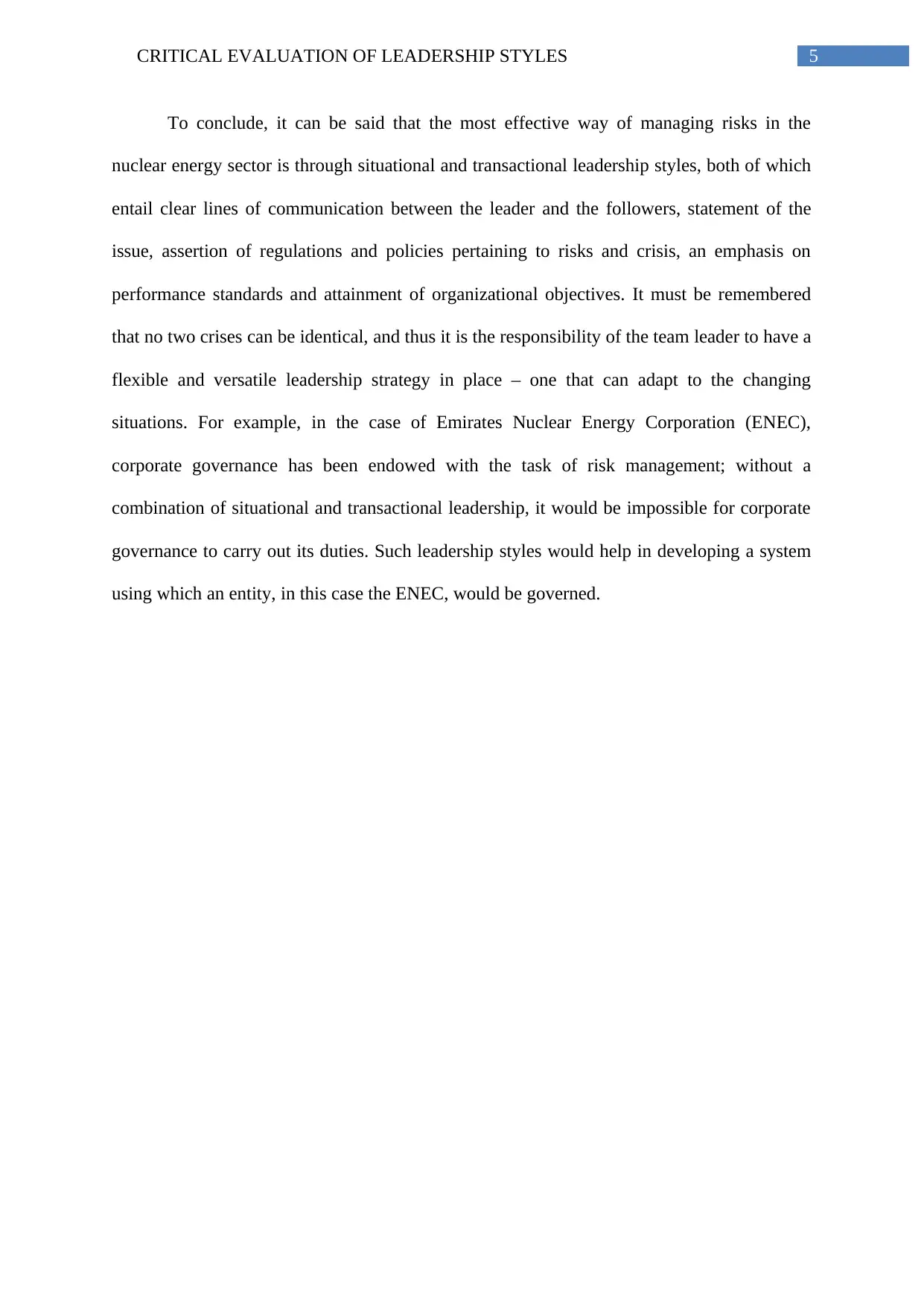
5CRITICAL EVALUATION OF LEADERSHIP STYLES
To conclude, it can be said that the most effective way of managing risks in the
nuclear energy sector is through situational and transactional leadership styles, both of which
entail clear lines of communication between the leader and the followers, statement of the
issue, assertion of regulations and policies pertaining to risks and crisis, an emphasis on
performance standards and attainment of organizational objectives. It must be remembered
that no two crises can be identical, and thus it is the responsibility of the team leader to have a
flexible and versatile leadership strategy in place – one that can adapt to the changing
situations. For example, in the case of Emirates Nuclear Energy Corporation (ENEC),
corporate governance has been endowed with the task of risk management; without a
combination of situational and transactional leadership, it would be impossible for corporate
governance to carry out its duties. Such leadership styles would help in developing a system
using which an entity, in this case the ENEC, would be governed.
To conclude, it can be said that the most effective way of managing risks in the
nuclear energy sector is through situational and transactional leadership styles, both of which
entail clear lines of communication between the leader and the followers, statement of the
issue, assertion of regulations and policies pertaining to risks and crisis, an emphasis on
performance standards and attainment of organizational objectives. It must be remembered
that no two crises can be identical, and thus it is the responsibility of the team leader to have a
flexible and versatile leadership strategy in place – one that can adapt to the changing
situations. For example, in the case of Emirates Nuclear Energy Corporation (ENEC),
corporate governance has been endowed with the task of risk management; without a
combination of situational and transactional leadership, it would be impossible for corporate
governance to carry out its duties. Such leadership styles would help in developing a system
using which an entity, in this case the ENEC, would be governed.
⊘ This is a preview!⊘
Do you want full access?
Subscribe today to unlock all pages.

Trusted by 1+ million students worldwide
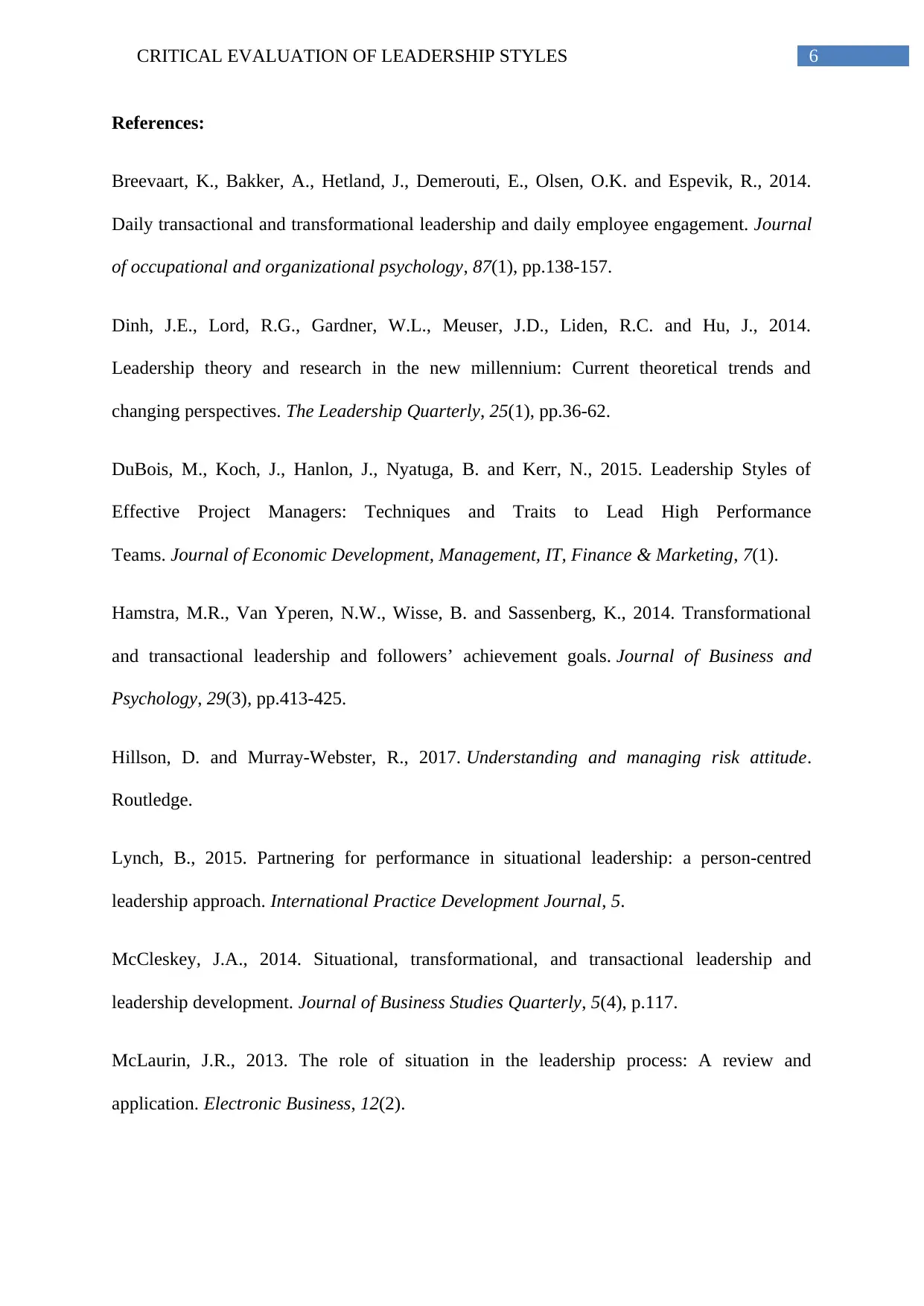
6CRITICAL EVALUATION OF LEADERSHIP STYLES
References:
Breevaart, K., Bakker, A., Hetland, J., Demerouti, E., Olsen, O.K. and Espevik, R., 2014.
Daily transactional and transformational leadership and daily employee engagement. Journal
of occupational and organizational psychology, 87(1), pp.138-157.
Dinh, J.E., Lord, R.G., Gardner, W.L., Meuser, J.D., Liden, R.C. and Hu, J., 2014.
Leadership theory and research in the new millennium: Current theoretical trends and
changing perspectives. The Leadership Quarterly, 25(1), pp.36-62.
DuBois, M., Koch, J., Hanlon, J., Nyatuga, B. and Kerr, N., 2015. Leadership Styles of
Effective Project Managers: Techniques and Traits to Lead High Performance
Teams. Journal of Economic Development, Management, IT, Finance & Marketing, 7(1).
Hamstra, M.R., Van Yperen, N.W., Wisse, B. and Sassenberg, K., 2014. Transformational
and transactional leadership and followers’ achievement goals. Journal of Business and
Psychology, 29(3), pp.413-425.
Hillson, D. and Murray-Webster, R., 2017. Understanding and managing risk attitude.
Routledge.
Lynch, B., 2015. Partnering for performance in situational leadership: a person-centred
leadership approach. International Practice Development Journal, 5.
McCleskey, J.A., 2014. Situational, transformational, and transactional leadership and
leadership development. Journal of Business Studies Quarterly, 5(4), p.117.
McLaurin, J.R., 2013. The role of situation in the leadership process: A review and
application. Electronic Business, 12(2).
References:
Breevaart, K., Bakker, A., Hetland, J., Demerouti, E., Olsen, O.K. and Espevik, R., 2014.
Daily transactional and transformational leadership and daily employee engagement. Journal
of occupational and organizational psychology, 87(1), pp.138-157.
Dinh, J.E., Lord, R.G., Gardner, W.L., Meuser, J.D., Liden, R.C. and Hu, J., 2014.
Leadership theory and research in the new millennium: Current theoretical trends and
changing perspectives. The Leadership Quarterly, 25(1), pp.36-62.
DuBois, M., Koch, J., Hanlon, J., Nyatuga, B. and Kerr, N., 2015. Leadership Styles of
Effective Project Managers: Techniques and Traits to Lead High Performance
Teams. Journal of Economic Development, Management, IT, Finance & Marketing, 7(1).
Hamstra, M.R., Van Yperen, N.W., Wisse, B. and Sassenberg, K., 2014. Transformational
and transactional leadership and followers’ achievement goals. Journal of Business and
Psychology, 29(3), pp.413-425.
Hillson, D. and Murray-Webster, R., 2017. Understanding and managing risk attitude.
Routledge.
Lynch, B., 2015. Partnering for performance in situational leadership: a person-centred
leadership approach. International Practice Development Journal, 5.
McCleskey, J.A., 2014. Situational, transformational, and transactional leadership and
leadership development. Journal of Business Studies Quarterly, 5(4), p.117.
McLaurin, J.R., 2013. The role of situation in the leadership process: A review and
application. Electronic Business, 12(2).
Paraphrase This Document
Need a fresh take? Get an instant paraphrase of this document with our AI Paraphraser
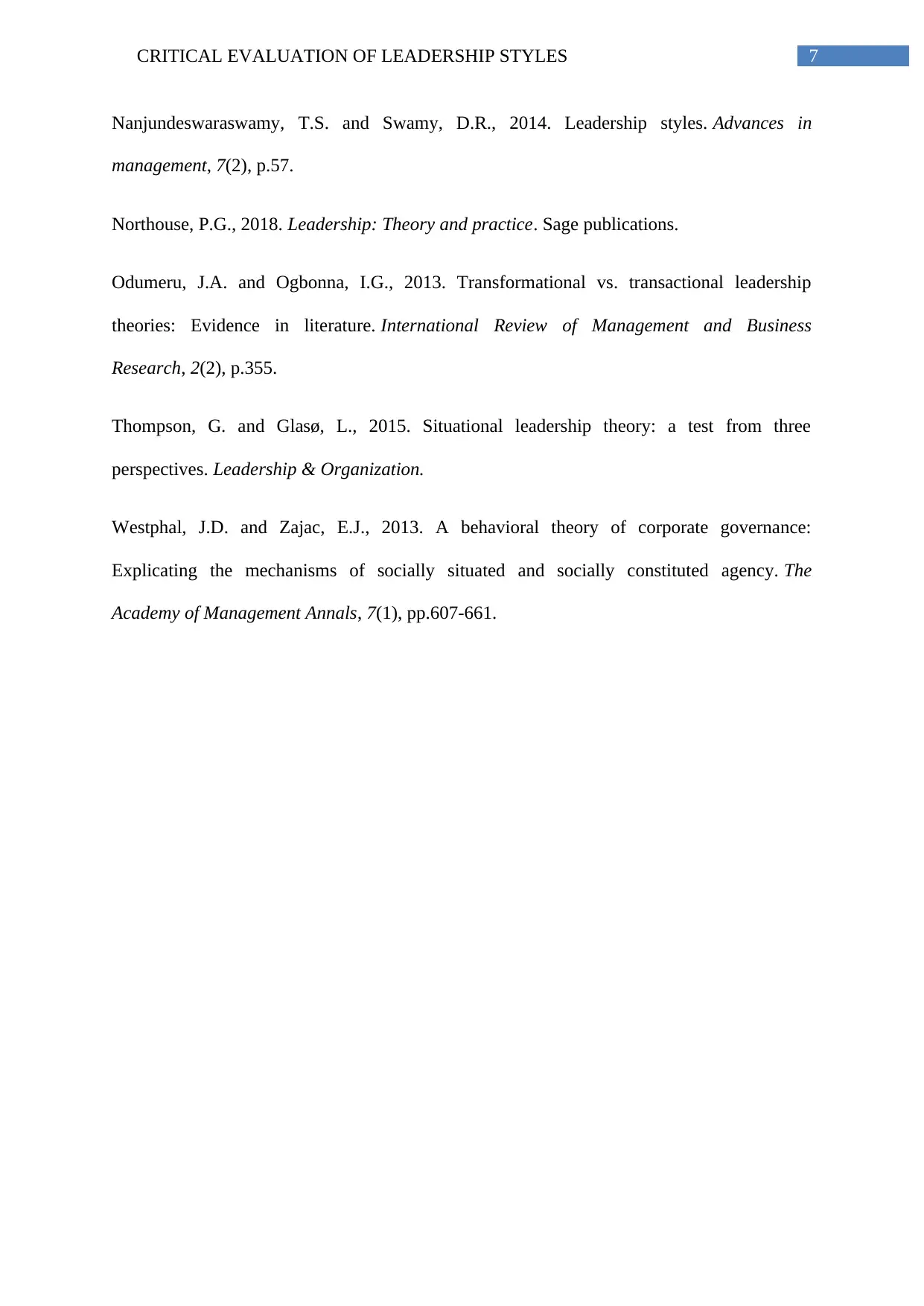
7CRITICAL EVALUATION OF LEADERSHIP STYLES
Nanjundeswaraswamy, T.S. and Swamy, D.R., 2014. Leadership styles. Advances in
management, 7(2), p.57.
Northouse, P.G., 2018. Leadership: Theory and practice. Sage publications.
Odumeru, J.A. and Ogbonna, I.G., 2013. Transformational vs. transactional leadership
theories: Evidence in literature. International Review of Management and Business
Research, 2(2), p.355.
Thompson, G. and Glasø, L., 2015. Situational leadership theory: a test from three
perspectives. Leadership & Organization.
Westphal, J.D. and Zajac, E.J., 2013. A behavioral theory of corporate governance:
Explicating the mechanisms of socially situated and socially constituted agency. The
Academy of Management Annals, 7(1), pp.607-661.
Nanjundeswaraswamy, T.S. and Swamy, D.R., 2014. Leadership styles. Advances in
management, 7(2), p.57.
Northouse, P.G., 2018. Leadership: Theory and practice. Sage publications.
Odumeru, J.A. and Ogbonna, I.G., 2013. Transformational vs. transactional leadership
theories: Evidence in literature. International Review of Management and Business
Research, 2(2), p.355.
Thompson, G. and Glasø, L., 2015. Situational leadership theory: a test from three
perspectives. Leadership & Organization.
Westphal, J.D. and Zajac, E.J., 2013. A behavioral theory of corporate governance:
Explicating the mechanisms of socially situated and socially constituted agency. The
Academy of Management Annals, 7(1), pp.607-661.
1 out of 8
Related Documents
Your All-in-One AI-Powered Toolkit for Academic Success.
+13062052269
info@desklib.com
Available 24*7 on WhatsApp / Email
![[object Object]](/_next/static/media/star-bottom.7253800d.svg)
Unlock your academic potential
Copyright © 2020–2025 A2Z Services. All Rights Reserved. Developed and managed by ZUCOL.





